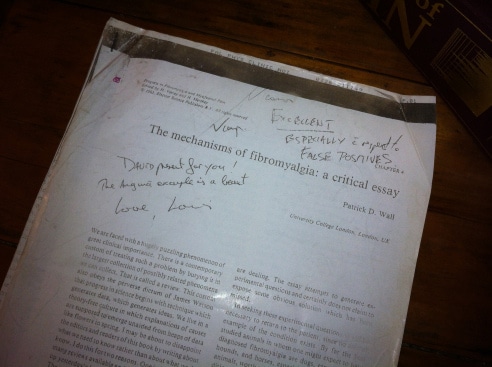
I’ve been digging into the dusty recesses of the noi archives recently, intrepidly exploring the cobwebbed piles of scrolls, leather bound tomes and stacks of parchments*. It’s a treasure trove of classics- from the esoteric The Tree of Knowledge from Maturana and Varela to the popular Why Zebras Don’t Get Ulcers by Robert Sapolsky. From little known volumes such as Nerve Injury and Repair by Lundborg (with the most amazing drawings of the microanatomy of peripheral nerve trunks) to the well known (but rarely seen in it’s mammoth size print version now days?) Textbook of Pain.
But the most valuable of these gems, like any good treasures, are hard to find – the old and well thumbed articles sandwiched between books, the photocopies of photocopies with scribbled notes in the margin and key sections underlined. One of these scientific literary jewels that I uncovered was a beautiful piece of writing from Patrick Wall. It’s an old yellowed fax, barely legible in parts on that funny, shiny paper that old fax machines used.
The mechanisms of fibromyalgia: a critical essay appeared as a chapter in the 1993 book Progress in Fibromyalgia and Myofascial Pain edited by Vaeroy and Merske. From the opening sentences, the chapter exudes Patrick Wall’s legendary wit, intellect and frank communication style.

We are faced with a hugely puzzling phenomenon of great clinical importance. There is a contemporary custom of treating such a problem by burying it in the largest collection of possibly related phenomena we can collect. That is called a review. The custom also obeys the perverse dictum of James Watson that progress in science begins with technique which generates data, which generates ideas. We live in a theory-free culture in which explanations of causes are supposed to emerge unaided from heaps of data like flowers in spring. I may be about to disappoint the editors and readers of this book by writing about what we need to know rather than about we do know. I do this for two reasons. One is that there are many reviews available and I see no reason to warm up yesterday’s hash as though it were a novel dish. The other is that I doubt that the available data is as objective and theory-free as reported. Inspection of experimental design and of the words used to describe data suggest a hidden agenda in which authors are, perhaps unwittingly, supporting a classical conclusion such as the separation of mind and body, or specific nerve energies or the nutritional origin of all diseases and so on. Here I only wish to place fibromyalgia as a painful syndrome in the context of other painful syndromes so that we may investigate the possible class of pains with which we are dealing. The essay attempts to generate experimental questions and certainly does not claim to expose some obvious solution which has been missed.
In seeking these experimental questions it will be necessary to return to the patient, since no animal example of the condition exists…
…The two-toed sloths of the Brazilian jungle move slowly with what appears to be a permanent hang-over or, in their case, a hang under. Do they have fibromyalgia? This is more than a joke question since it would be a very important finding if it were true that fibromyalgia is a unique design defect, common to most humans, and yet is absent in the rest of the vertebrate kingdom. An answer to this simple low tech question would be an example of putting the syndrome of fibromyalgia in context, which is the strategy of this chapter.
There’s so much to take away from just this opening – the nature of science and of scientific research and writing, epistemology and the nature of knowledge, reasoning about pain and ‘classes of pain’ from a phenomenological, but also an evolutionary perspective, and the need to ask the right questions in order to seek clinically relevant answers.
While Wall takes a swipe at some of his contemporaries with his definition of a review, and adds some humour with his question about the two-toed sloth, there is no doubt that he takes the subject matter very seriously – a puzzling phenomenon of great clinical importance, and is focussed on the most important feature of the phenomenon; that it is experienced by a person – In seeking these experimental questions it will be necessary to return to the patient…
I think this paper may lead to a series of posts – there’s a lot of depth to share.
-Tim Cocks
*There may or may not be actual scrolls, parchments and leather bound tomes at noi – this might be some poetic license…
Get your think on and get up to date at a noigroup course, or immerse yourself in some brainy books with Explain Pain 2nd Ed and The Graded Motor Imagery Handbook

“In seeking these experimental questions it will be necessary to return to the patient”……..as it is the patient who holds all the answers ……
“Knock and the door will open,
Seek and you shall find,
Ask and you’ll be given,
The key to this heart of mine” (Dean Martin, Welcome to my World)
DB London
On location
Ciao DB (on location)
Found it.
https://www.youtube.com/watch?v=qX7BAfXn85Y
Love it!
Tim
Tim – I am glad you have enjoyed exploring the “archives” at NOI. I note Louis Gifford’s comments on that lovely old fax of Pat Wall writings that you found. Talking of the scientist seeking answers from the patient, Wall loved having beers with clinicians and he would ask “what are you seeing at the battlefront.” I am wondering if he would note any really great changes in clinical behaviours today.
David
Great post! So much to think about here…
Thanks,
Toby